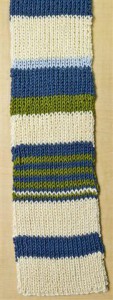A scarf of one’s own – The Press, October 28th 2009
 Any time of year, a scarf is a popular accessory. Why don’t you design your own one of a kind summer scarf.
Any time of year, a scarf is a popular accessory. Why don’t you design your own one of a kind summer scarf.
I have a favourite scarf pattern that I use all year round. It’s reversible, keeps it shape well and looks good in many different yarns. For both men and women, it knits up handsomely in wools for winter and bamboo, cotton or silks in summer.
When designing your own, the only rule is there are no rules – this is your own personal design. Think about the colours that remind you of summer: sea, sand, sky, strolling along the beach, summer grasses, picture of the light and shade…
Take a sheet of paper and draw a long rectangle. Using coloured pencils, design your own scarf, placing stripes wherever you want. Draw a number of trials, changing the placement of colours and width of stripes until you feel happy with the effect. How wide do you want it to be, how long?
Take your design with you to a wool shop and ask for assistance. How much yarn in each colour will you need? It’s all about proportions, and the people who work in wool shops field such questions every day and willingly help with suggestions as to types of yarn and colours available and the amount you will require to complete your scarf. Always search for the best yarns you can afford; good materials contribute to good design. If you don’t like the yarn, don’t buy it; you are making an accessory that will take time and will be worn on numerous occasions, so take care in your choices.
If you choose to knit with cottons or silks, remember that they have a tendency to move south and stay there when knitted on larger needles, so use a thinner gauge needle and the fabric will stay where you want it to. Both cotton and silk will behave better if mixed with another yarn. Wool is a good companion as it has a good memory and will help keep the fabric in shape.
The pictured scarf was knitted using 38 stitches on size 4mm needles in a single rib (knit1, purl 1) stitch pattern. The inspiration was summer with a thirties influence – the geometry of naughty and nice. I used a combination of bamboo, wool and cotton yarns. The cream base colour is a Sirdar Bamboo/wool mix, as is the dark blue. The cottons come from the Rowan range. The double knit green cotton has a gorgeous acid lime look, while the pale blue is a more delicate 4 ply.
When mixing yarns produced by different manufacturers you may find that even though they are labelled the same ply they may actually be of differing widths, so you may have to change needles to maintain the tension. This applies also to mixing plys. I could have doubled the 4 ply yarn but chose not to. Just go for the effect you want to create. Your stripes might be one, two, ten or more rows, repeating patterns or random stripes, it’s all up to you.
In general, when joining your yarn, do so at the end of a row and knot it as close to the edge as possible to retain tension, then continue knitting. If the colour change is just for a row or two you can trammel the yarn up the side of the scarf by wrapping the two yarns together, thus avoiding a join. However, remember, there are no rules, only recommendations. This is your own design and you can join your yarn in the middle of a row if that is the effect you want to create (just make sure you tie a knot that will not come loose with wear or your scarf will unravel).
When you have completed your knitting to the length of your choice, return to those knots, undo them and, using a sewing needle, stitch the threads together and run them along the fabric edge of the scarf.
I got a bit carried away with the stripes, using all widths from single rows to wide blocks of twelve or more rows of colour and enjoyed knitting my way to producing a scarf about two metres in length.
MBW